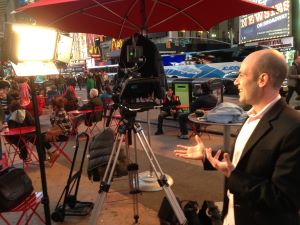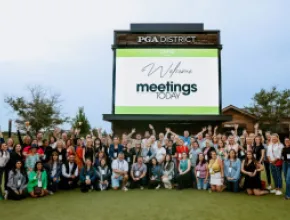OMG! Have a great idea, unique insight or informed opinion that you just can’t wait to share? BZZT! Sorry, friend, but as it turns out, you’re just not that fascinating….

Of course, I’m simply joking around here, but it serves to illustrate a helpful point. Specifically, that in a market where audiences are exposed to a skyrocketing number of marketing messages daily—and human attention spans have shrunk to just eight seconds (less than that of a goldfish)—it’s becoming harder than ever to capture and hold audiences’ attention.
Noting this, and having served as a keynote speaker and trainer for hundreds of organizations, I’ve found that it’s important to rethink how we fundamentally design presentations—especially those delivered virtually—to make audiences immediately tune in and keep them from tuning out.
Following, you’ll find a number of expert hints, tips and insights that can help you and the speakers you hire for your meetings—whether virtual or in-person—more effectively connect with and engage with modern viewers, and (regardless of whatever subject matter or format you’re working with), more effectively stand out.
Make Problem-Solving Your Priority
Viewers’ schedules are more crowded and job roles more demanding than ever. Noting this, they’re not tuning in to hear you pontificate, but rather help them solve pressing problems. To this extent, all presentations (virtual or otherwise) should be geared toward providing either one of the following:
- A paradigm shift in the way others think
- A handful of mission-critical insights
- Perhaps most important, one to three key action steps that audiences can immediately begin taking upon completion to better their situation.
[Related: 7 Clever Ways to Market and Promote Your Virtual Event]
As you go about designing presentations, consider the following: What key challenges are your audiences facing on the job and how can you offer solutions that help viewers quickly address them? Then distill the essence of your presentation down to how you can help them solve these problems and present your material in a clear, concise and instantly accessible narrative format.

Differentiate Out of the Gate
Pro tip: If you’re not immediately memorable from the opening buzzer, you can forget about ever capturing, let alone holding, audiences’ interest. Whatever hook you choose to lead speeches with (i.e., humor, authority, quirkiness, urgency, empathy, etc.), make sure you instantly leap off the screen and differentiate yourself in the mind of viewers.
Simple tricks you can use to do so include leading with an offbeat joke or memorable story; taking a contrarian stance on common business practices or beliefs; or simply piggybacking on trending news topics.
For example: Adding an endearing sight gag to your presentation, e.g., a slide featuring a silly internet meme about working from home or dealing with disruption in the COVID-19 era would offer a quick-hit, easy way to instantly pique viewers’ attention.
Let Imagery Do the Talking
There’s a reason they say a picture is worth a thousand words: It’s because graphics, animations, videos and illustrations serve as a form of rapid learning and mental shorthand.
Using charts, graphs and illustrations across your presentation can not only help you simplify complex concepts in seconds. It can also help you catch audiences’ eyes, break up otherwise dense layers of content, and give viewers the “CliffsNotes” they need to get a handle on sophisticated ideas and concepts.
Given the limited time you’re provided in most presentations (45-60 minutes on stage, or 15-30 minutes in virtual format), there’s seldom enough breathing room to wax philosophical on a subject. Your goal as a speaker should typically be to quickly introduce a concept, provide a top-level overview, and give audiences the tools, methodologies and formulas they need to dive deeper.
Visual elements can help you more rapidly do so and (in the event you’re looking to cram added value into your presentations) quickly expand further on information presented in spoken-word format. In effect, leveraging the power of data visualization (using colorful, eye-catching graphics and images to quickly convey important information) is one of the fastest ways to grab others’ attention and communicate complex ideas in simple fashion.
Procced at a Brisk Clip
Pacing is important: Roughly one minute of speaking per slide makes sense, especially for online audiences (who bore easily), and for every two slides of content, a third should be used to break this material up by peppering it with engaging case studies, stories or examples. Your energy should also be strong and consistent at all times throughout your presentation and all material delivered with a positive and upbeat outlook.
As you write your speech, remember that means penning roughly 75 to 100 words maximum per slide; devoting no more than two to three sentences to a single given point; and universally putting an optimistic spin on breaking trends and developments.
Remember: People will feed off your insight and energy, and much of what they take away from the program will be in the framing and presentation. For instance, as I like to remind audiences, while change and disruption may seem intimidating, they can also serve as sources of inspiration and great motivators for change and innovation. Likewise, while new technology trends including robotics and automation may eliminate certain job roles, they’ll also create greater demand in other spaces, such as for individuals skilled in managing data and analytics.
Add More Audience Interaction
Call and response activities, online group exercises and app-based polls or surveys can also serve as helpful tools to keep audiences engaged. Similarly, I also like to break large blocks of time into clearly divided sections (e.g., 20 minutes of keynote, then 20 more of workshop and a final 20 of panel discussion or Q&A) to keep things fresh and interesting.
Whatever your preferred way of getting viewers more involved—inviting surprise guests to show up, asking audiences to participate in small working groups, using party games to break the ice, etc.—the important thing is to try to make conversation a two-way street. The more audiences are talked with, not at, the better off you’ll often be.
Lead With Impact
As a virtual or keynote presenter, remember: Your goal isn’t simply to command audiences’ attention, it’s also to make them reconsider their situation, revisit scenarios from fresh angles, and, having reimagined their current state of affairs in context, make smarter and more effective decisions.
Think of it this way: As a general rule, you’re not just there to provide inspiration, but also motivation, and a clear path that can help them bridge the gap from where they are to where they want to be. That means making them think, making them feel, and helping their mind to seeing the world in new ways as well.
Luckily, if you follow the rules and guidelines outlined above, you’ll already be far along in your efforts to successfully connect with and engage modern audiences—and one step ahead when it comes to designing meeting programs that make a lasting impression.







